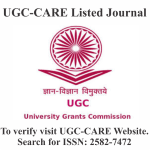THE IMPACT OF HINDI CINEMA ON ALTERING THE ADULTS’ PERCEPTION TOWARDS SOCIETAL STEREOTYPES: A STUDY OF DELHI NCR
DOI:
https://doi.org/10.29121/shodhkosh.v5.i1.2024.915Keywords:
Hindi Cinema, Impact, Societal Stereotypes, Adul, PerceptionAbstract [English]
Hindi cinema, with its immense popularity and pan-India reach has long been recognized as an influential socio-cultural force in the country. Through propagation of enduring stereotypes in films, it contributes to shaping and reinforcing the attitudes and perceptions of audiences regarding gender roles, communities, professions and societal values. This study aimed to examine the impact of exposure to stereotypical Hindi cinema on altering adults’ perceptions towards commonly accepted societal stereotypes in the Delhi NCR region.
A sample of 217 adults aged 18-35 above years was surveyed using questionnaires to assess cinema viewership patterns, endorsement of societal stereotypes portrayed in Hindi movies. The findings highlight the powerful influence Hindi cinema wields in combating regressive stereotypes in society especially among vulnerable sections like the rural poor with limited education. But rising education levels are breeding resistance to such stereotyped beliefs. The paper recommends that Hindi filmmakers should consciously avoid harmful stereotypes and attempt progressive portrayals of gender, caste, class and professions. Responsible cinema can play a transformative role in promoting egalitarian attitudes aligned with India’s development goals.
Downloads
References
Ashmore, R. D., & Del Boca, F. K. (1981). Conceptual Approaches to Stereotypes and Stereotyping. Cognitive Processes in Stereotyping and Intergroup Behavior, 1, 35.
Bandura, A. (2001). Social Cognitive Theory of Mass Communication. Media Psychology, 3(3), 265–299. https://doi.org/10.1207/S1532785XMEP0303_03 DOI: https://doi.org/10.1207/S1532785XMEP0303_03
Baran, S. J., & Davis, D. K. (2009). Mass Communication Theory: Foundations, Ferment, and Future (6th Ed.). Wadsworth Cengage Learning.
Behm-Morawitz, E., & Ortiz, M. (2013). Race, Ethnicity, and the Media. In K. E. Dill (Ed.), The Oxford Handbook of Media Psychology. Oxford University Press, 252-266. DOI: https://doi.org/10.1093/oxfordhb/9780195398809.013.0014
Bharucha, R. (2014). Indian Cinema. Sydney University Press.
Chopra, A. (2011). Celebrity, Consumption and Development in Post-Liberalized India. Media International Australia, Incorporating Culture & Policy, 140(1), 76–85. https://doi.org/10.1177/1329878X1114000110 DOI: https://doi.org/10.1177/1329878X1114000110
Crocker, J., & Lutsky, N. (1986). Stigma and the Dynamics of Social Cognition. Social Cognition and Clinical Psychology: A Synthesis, 95-121. https://doi.org/10.1007/978-1-4684-7568-5_6 DOI: https://doi.org/10.1007/978-1-4684-7568-5_6
Desai, J. (2004). Planet Bollywood: Indian Cinema Abroad. In R. Dwyer & C. Pinney (Eds.), Pleasure and the Nation. Oxford University Press, 198-224.
Desai, J., & Basuroy, S. (2005). Interactive Influence of Genre Familiarity, Star Power, and Critics' Reviews in the Cultural Goods Industry: The Case of Motion Pictures. Psychology & Marketing, 22(3), 203–223. https://doi.org/10.1002/mar.20055 DOI: https://doi.org/10.1002/mar.20055
Dwyer, R. (2014). Bollywood's India: Hindi Cinema as a Guide to Modern India. Reaktion Books.
Ganti, T. (2004). Bollywood: A Guidebook to Popular Hindi Cinema. Routledge.
Gerbner, G., Gross, L., Morgan, M., Signorielli, N., & Shanahan, J. (2002). Growing up with Television: Cultivation Processes. Media Effects: Advances in Theory and Research, 2, 43-67.
Gokulsing, K. M. (2004). Soft-Soaping India: The World of Indian Televised Soap Operas. Trentham Books.
Gorham, B. W. (1999). Stereotypes in the Media: So What? Howard Journal of Communication, 10(4), 229-247. https://doi.org/10.1080/106461799246778 DOI: https://doi.org/10.1080/106461799246735
Hilton, J. L., & Von Hippel, W. (1996). Stereotypes. Annual Review of Psychology, 47, 237-271. DOI: https://doi.org/10.1146/annurev.psych.47.1.237
Holbert, R. L., Shah, D. V., & Kwak, N. (2004). Fear, Authority, and Justice: Crime-Related TV Viewing and Endorsements of Capital Punishment and Gun Ownership. Journalism & Mass Communication Quarterly, 81(2), 343-363. https://doi.org/10.1177/107769900408100205 DOI: https://doi.org/10.1177/107769900408100208
Igartua, J.-J., & Barrios, I. (2012). Changing Real-World Beliefs with Controversial Movies: Processes and Mechanisms of Narrative Persuasion. Journal of Communication, 62(3), 514–531. https://doi.org/10.1111/j.1460-2466.2012.01640.x DOI: https://doi.org/10.1111/j.1460-2466.2012.01640.x
Karan, K. (2008). Observations on Change and Changelessness in Indian Cinema. India International Centre Quarterly, 34(4), 25-35.
Kaur, R. (2002). Viewing the West through Bollywood: A Celluloid Occident in the Making. Contemporary South Asia, 11(2), 199-209. https://doi.org/10.1080/0958493022000017273 DOI: https://doi.org/10.1080/0958493022000030168
Khan, S., Sultana, N., & Wahid, S. S. (2016). Gender Stereotypes in Hindi Cinema: A Content Analysis Study. Journal of Humanities and Social Science, 21(9), 38-44. https://doi.org/10.9790/0837-2109053844
Mazzarella, W. (2003). Shoveling Smoke: Advertising and Globalization in Contemporary India. Duke University Press. DOI: https://doi.org/10.1515/9780822385196
Punathambekar, A. (2013). From Bombay to Bollywood: The Making of a Global Media Industry. NYU Press.
Ramasubramanian, S. (2011). The Impact of Stereotypical Versus Counterstereotypical Media Exemplars on Racial Attitudes, Causal Attributions, and Support for Affirmative Action. Communication Research, 38(4), 497–516. https://doi.org/10.1177/0093650210384854 DOI: https://doi.org/10.1177/0093650210384854
Ramasubramanian, S. (2015). Using Celebrity News Stories to Effectively Reduce Racial/Ethnic Prejudice. Journal of Social Issues, 71(1), 123–138. https://doi.org/10.1111/josi.12100 DOI: https://doi.org/10.1111/josi.12100
Rao, S. (2010). I Need an Indian Touch: Glocalization and Bollywood Films. Networking Knowledge, 3(1), 23-34. https://doi.org/10.31165/nk.2010.31.276 DOI: https://doi.org/10.1080/17513050903428117
Sharma, P. (2018). Gender Construction Through Media Consumption Choices: Impacting Attitudes and Behaviours Towards Love and Marriage. Media Watch, 9(3), 414-426. http://dx.doi.org/10.15655/mw/2018/v9i3/49592
Shaver, J. H., Sibley, C. G., Osborne, D., & Bulbulia, J. (2017). News Exposure Predicts Anti-Muslim Prejudice. PloS one, 12(3). https://doi.org/10.1371/journal.pone.0174606 DOI: https://doi.org/10.1371/journal.pone.0174606
Shrum, L. J. (2004). The Cognitive Processes Underlying Cultivation Effects are a Function of Whether the Judgments are On-Line or Memory-Based. Communications, 29(3), 327–344. https://doi.org/10.1515/comm.2004.021 DOI: https://doi.org/10.1515/comm.2004.021
Shrum, L. J., & Lee, J. (2012). The Stories TV Tells: How Fictional TV Narratives Shape Normative Perceptions and Personal Values. In L. J. Shrum (Ed.), The Psychology of Entertainment Media: Blurring the Lines Between Entertainment and Persuasion. Routledge. (2nd Ed), 147-167.
Virdi, J. (2003). The Cinematic Imagination: Indian Popular Films as Social History. Rutgers University Press.
Published
How to Cite
Issue
Section
License
Copyright (c) 2024 Karan Singh, Dr. Mohammad Aamir Pasha, Dr. Shivendu Kumar Rai

This work is licensed under a Creative Commons Attribution 4.0 International License.
With the licence CC-BY, authors retain the copyright, allowing anyone to download, reuse, re-print, modify, distribute, and/or copy their contribution. The work must be properly attributed to its author.
It is not necessary to ask for further permission from the author or journal board.
This journal provides immediate open access to its content on the principle that making research freely available to the public supports a greater global exchange of knowledge.

























